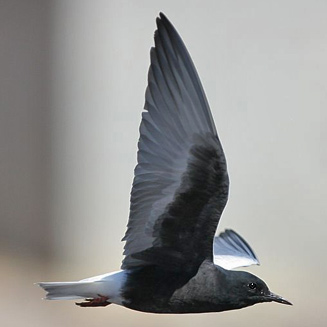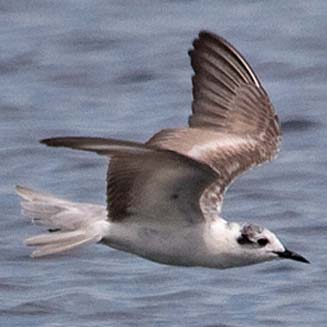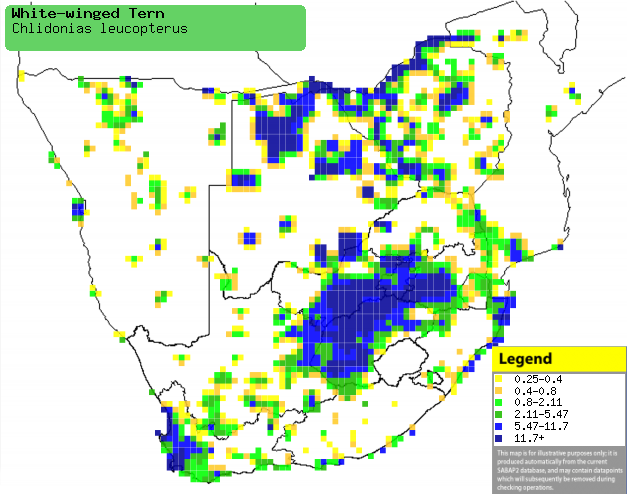|
Chlidonias leucopterus
(White-winged tern)
Witvlerksterretjie [Afrikaans]; Witvleugelstern [Dutch];
Guifette leucoptère [French]; Weißflügel-seeschwalbe [German];
Gaivina-d'asa-branca [Portuguese]
Life
> Eukaryotes >
Opisthokonta
> Metazoa (animals) >
Bilateria >
Deuterostomia > Chordata >
Craniata > Vertebrata (vertebrates) > Gnathostomata (jawed
vertebrates) > Teleostomi (teleost fish) > Osteichthyes (bony fish) > Class:
Sarcopterygii (lobe-finned
fish) > Stegocephalia (terrestrial
vertebrates) > Tetrapoda
(four-legged vertebrates) > Reptiliomorpha > Amniota >
Reptilia (reptiles) >
Romeriida > Diapsida > Archosauromorpha > Archosauria >
Dinosauria
(dinosaurs) > Saurischia > Theropoda (bipedal predatory dinosaurs) >
Coelurosauria > Maniraptora > Aves
(birds) > Order: Charadriiformes
> Family: Laridae > Genus: Chlidonias
 |
 |
| White-winged tern in breeding plumage, Paarl Bird
Sanctuary, South Africa. [photo Trevor Hardaker ©] |
White-winged tern in non-breeding plumage. [photo
Neil Gray
©] |
Distribution and habitat
Breeds in the area from China to central Europe, heading
south in the non-breeding season to south-east Asia, northern Australia and most
of sub-Saharan Africa. Within southern Africa
it is common in southern Mozambique, Zimbabwe, northern and south-eastern
Botswana, central and northern Namibia (including the Caprivi Strip) and central
and south-western South Africa. It generally prefers inland wetlands, either
natural or artificial, such as sewage works and salt pans; it is generally more
scarce at coastal estuaries and wetlands.
|
 |
|
Distribution of White-winged tern in southern Africa,
based on statistical smoothing of the records from first SA Bird Atlas
Project (©
Animal Demography unit, University of
Cape Town; smoothing by Birgit Erni and Francesca Little). Colours range
from dark blue (most common) through to yellow (least common).
See here for the latest distribution
from the SABAP2. |
Predators and parasites
It has been recorded as prey of
Falco peregrinus
(Peregrine falcon).
Movements and migrations
Most birds arrive in southern Africa in the
period from August-November, probably originating from breeding
grounds in central Asia. In February it begins to gather in flocks
at the South African highveld, before leaving the region by April.
Food
It mainly eats invertebrates and small fish, doing most of
its foraging in flocks, flying upwind to catch flying insects before letting the
wind carry it back so that it can repeat the process. It also regularly plunge
dives for fish and is attracted to fishing boats, eating the fish they discard.
Other techniques employed include following catfish (Clarias) to
catch the animals disturb and seizing prey from the ground or water surface.
The following food items have been recorded
in its diet:
- Invertebrates
- insects
-
arachnids
- Caradina nilotica (freshwater shrimp)
- Uca (estuarine fiddler crabs)
- Fish
- Limnothrissa miodon (Tanzanian sardines)
- Pharyngochromis acuticeps (Zambezi river bream)
- Synodontis (squeakers)
Threats
Not threatened, in fact widespread and common, although
susceptible to botulism.
References
-
Hockey PAR, Dean WRJ and Ryan PG 2005. Roberts
- Birds of southern Africa, VIIth ed. The Trustees of the John Voelcker
Bird Book Fund, Cape Town.
|
